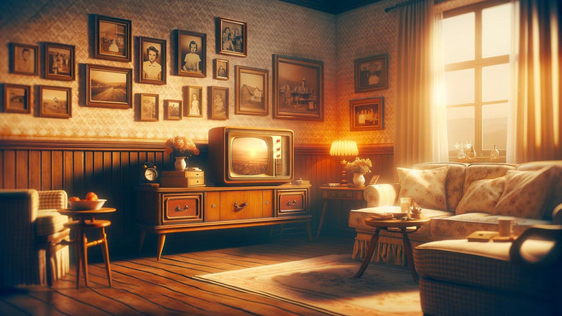In the past decade or so, Hollywood and global cinema have been looking backward—not just in the form of historical epics, but in reboots, remakes, sequels, and movies saturated in stylistic nod. From 1980s fashion revivalism in Stranger Things to franchise revivals like Ghostbusters, Jurassic Park, Top Gun, and even The Matrix, it's clear that nostalgia has become the defining impulse of modern filmmaking.

Why is there this wave of cinematic sentimentality? Why are we just recycling old stories, old aesthetics, even old stars? And what does it say about the movie business, and the audience?
Let's dive into the cultural, psychological, and economic motivations behind why nostalgia could be on the rise at the movie industry.
A Safe Bet in the Industry
Hollywood is always a risk-averse business. It's a multi-million-dollar gamble to produce a blockbuster movie, and the enticement of an audience in place makes nostalgia-themed projects especially attractive. Seeing old movies recreated or continued is making sure that it will do well.
Sequels and reboots offer a level of brand recognition that new ideas can't compete with. Studios are more willing to spend money on established properties because they lower financial risk. That's why years-dead-old properties, such as Blade Runner or Indiana Jones, are being revived, occasionally decades after they had been forgotten.
This is not only a Hollywood phenomenon. Bollywood too re-releases old success stories every so often. European art cinema takes on themes and look from different decades. Even Netflix and Disney+ cash in on nostalgia with spin-offs, revivals, and remakes.
The Comfort of the Familiar
Viewers are also culpable for this trend. Nostalgia is a promise of comfort, something increasingly attractive in times of uncertainty. Viewings for classic movies skyrocketed when the world was in the midst of crises like the COVID-19 pandemic. Streaming platforms saw unforeseen surges of watching the classic films like Back to the Future, The Princess Bride, and Harry Potter.
Psychologically, nostalgia has been shown to improve mood, reduce stress levels, and make individuals feel more connected to society. Retreating to a childhood or adolescent favorite film isn't just entertainment—it's therapy. Cinema is an emotional time machine, allowing us to travel to a time when the world maybe seemed more innocent or more optimistic.
Stylistic Homage and Retro Revival
Nostalgia also doesn't necessarily translate to direct remakes or sequels. A few of the most innovative films of the decade use retro aesthetics and narrative approaches in fresh ways.
Take La La Land (2016), which pays homage to the 1950s Technicolor musicals. Or Drive (2011), drenched in neon and synth-pop straight from the '80s. Horror is no exception: It Follows (2014) and The Black Phone (2021) are both old-fashioned, VHS-era creepiness.
Directors like Quentin Tarantino and Greta Gerwig are prone to writing love letters to the past. Tarantino's Once Upon a Time in Hollywood sends viewers back to 1969 Los Angeles, and Gerwig's Barbie mingles colorful '50s dollhouse kitsch with postmodern storytelling. These directors are not so much pandering to the past as re-imagining it for their audience now.
The Double-Edged Sword of Nostalgia
Nostalgia in movies is a double-edged sword, a mighty weapon.
On the other hand, it reminds viewers of timeless classics and accesses cultural memory. It can inspire younger viewers to visit timeless classics and grant older viewers the chance to witness cinematic landmarks.
At the same time, it can stifle innovation. When studios prioritize established IP over new storylines, it becomes harder for fresh voices and fresh ideas to penetrate. For each successful reboot, there are hundreds of forgettable ones that rely too heavily on fan service but add nothing new.
And worst of all, nostalgia can be a trap, a kind of cinematic comfort food that leads to an aversion to risk-taking and creativity.
What can go wrong?
The remakes and nostalgic looks into the past are sometimes not well done. While watching the new Snow White movie I was truly disappointed. The actors weren't chosen well and the wardrobe was disappointing.
I've seen school productions make better dresses for Snow White. As much as I love Rachel Zegler she just wasn't the one for the part. And not casting real dwarves because it's offensive is just more offensive to the dwarves in the need of money.
Not everything has to be made into a live action or a recreation. Some movies can just be left alone.
Where Do We Go From Here?
Then what's the future of nostalgia at the movies?
If current trends continue, we’ll likely see a deeper dive into the aesthetics and stories of the 1990s and early 2000s. We’re already seeing this in films like Captain Marvel, Turning Red, and shows like Freaks and Geeks, Yellowjackets, or That '90s Show. Even Y2K aesthetics are making a comeback in fashion and music videos—cinema won’t be far behind.
At the same time, a countercurrent is in formation. Foreign artists and independent directors are pushing back against nostalgia's grip, engaging in themes of the times, new stories, and unorthodox style. A rich film culture will need both: the familiarity of the past and the jolt of the new.
Final Thoughts
Nostalgia is not inherently evil. It can be beautiful, poignant, and even transgressive. But like any emotion, it must be handled carefully. When used intelligently, it deepens our love of the film heritage. When used, it's a hollow echo of what once was.
Movies are all about telling stories—and the best stories don't just retell the past. They borrow from it, challenge it, and move us forward.
So go ahead: rewatch your favorites. Enjoy the warm glow of nostalgia. But keep an eye out for something new, too. Because sometimes the next great movie isn’t one we’ve already seen—it’s one we’ve never imagined.
Add comment
Comments